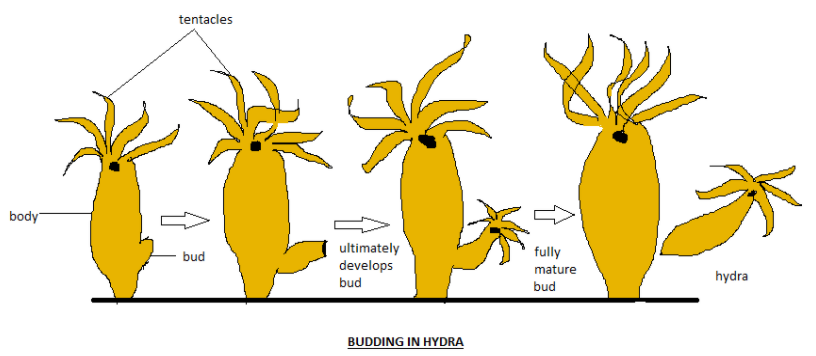
What is budding? Explain the budding in Hydra by the help of diagrams.
Answer
512.1k+ views
Hint: Budding is the process of production of new organisms. It is an asexual mode of reproduction. Examples of budding are yeast, hydra, corals, jellyfish, etc. It is associated with both unicellular and with multicellular organisms.
Complete answer:
>In budding, a new individual developed from a small part of the parent. A bud that is formed during budding detaches itself from the parent body and develops into a new organism. At the time of separation, a new individual leaves scar tissue behind them.
>Budding in hydra takes place by the regenerative cells in which bud extends as an outgrowth as shown in the diagram. These buds develop into a new organism which detaches them from the parent body at the time of maturation.
>Hydra is found in freshwater. It is small and has a tubular structure that is composed of tentacles. In hydra, budding involves a small bud which is developed from their parent hydra by the help of mitotic cell division.
>Small buds receive protein and nutrition from the parent hydra. They grow healthy and their growth starts by developing mouth and small tentacles. Finally, hydra separated from their parent body and became an independent organism.

Note:As budding is a type of asexual reproduction. So, a newly developed individual is a replica of their parents and they are genetically similar. Budding takes place in unicellular organisms as well as multicellular organisms. Both hydra and yeast can be reproduced by the help of budding.
Complete answer:
>In budding, a new individual developed from a small part of the parent. A bud that is formed during budding detaches itself from the parent body and develops into a new organism. At the time of separation, a new individual leaves scar tissue behind them.
>Budding in hydra takes place by the regenerative cells in which bud extends as an outgrowth as shown in the diagram. These buds develop into a new organism which detaches them from the parent body at the time of maturation.
>Hydra is found in freshwater. It is small and has a tubular structure that is composed of tentacles. In hydra, budding involves a small bud which is developed from their parent hydra by the help of mitotic cell division.
>Small buds receive protein and nutrition from the parent hydra. They grow healthy and their growth starts by developing mouth and small tentacles. Finally, hydra separated from their parent body and became an independent organism.

Note:As budding is a type of asexual reproduction. So, a newly developed individual is a replica of their parents and they are genetically similar. Budding takes place in unicellular organisms as well as multicellular organisms. Both hydra and yeast can be reproduced by the help of budding.
Recently Updated Pages
What happens to glucose which enters nephron along class 10 biology CBSE

Write a dialogue with at least ten utterances between class 10 english CBSE

A circle is inscribed in an equilateral triangle and class 10 maths CBSE

When the JanmiKudian Act was passed that granted the class 10 social science CBSE

A sector containing an angle of 120 circ is cut off class 10 maths CBSE

The sum of digits of a two digit number is 13 If t-class-10-maths-ICSE

Trending doubts
The shortest day of the year in India

Why is there a time difference of about 5 hours between class 10 social science CBSE

Write a letter to the principal requesting him to grant class 10 english CBSE

What is the median of the first 10 natural numbers class 10 maths CBSE

The Equation xxx + 2 is Satisfied when x is Equal to Class 10 Maths

What is the missing number in the sequence 259142027 class 10 maths CBSE




